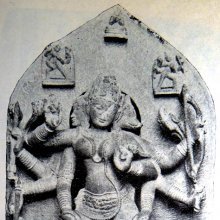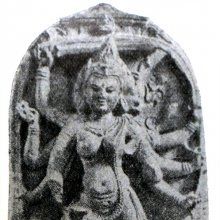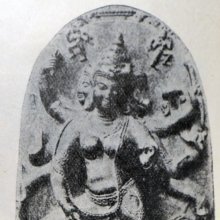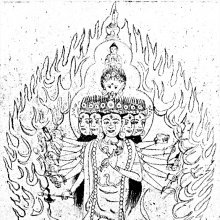Varahamukhi, Vārāhamukhī: 3 definitions
Introduction:
Varahamukhi means something in Buddhism, Pali, Hinduism, Sanskrit. If you want to know the exact meaning, history, etymology or English translation of this term then check out the descriptions on this page. Add your comment or reference to a book if you want to contribute to this summary article.
Images (photo gallery)
In Hinduism
Purana and Itihasa (epic history)
Source: Cologne Digital Sanskrit Dictionaries: The Purana IndexVārāhamukhī (वाराहमुखी).—A Śakti.*
- * Brahmāṇḍa-purāṇa IV. 20. 37.

The Purana (पुराण, purāṇas) refers to Sanskrit literature preserving ancient India’s vast cultural history, including historical legends, religious ceremonies, various arts and sciences. The eighteen mahapuranas total over 400,000 shlokas (metrical couplets) and date to at least several centuries BCE.
In Buddhism
Tibetan Buddhism (Vajrayana or tantric Buddhism)
Source: archive.org: The Indian Buddhist IconographyVarāhamukhī (वराहमुखी) refers to one of the fur attendant goddesses of Aṣṭabhujamārīcī (or Mārīcīpicuvā) or the eight-armed variety of Mārīcī, who represents one of the various emanations of Vairocana, as mentioned in the 5th-century Sādhanamālā (a collection of sādhana texts that contain detailed instructions for rituals).—[...] Accordingly, Aṣṭabhuja-Mārīcī is surrounded by the four attendant goddesses, Varttālī, Vadālī, Varālī and Varāhamukhī. [...] Varāhamukhī wears the same garments and the same ornaments as Vadālī and Varālī, but her complexion is ruddy, and she carries the vajra and the arrow in the two right hands and the Aśoka and the bow in the left.

Tibetan Buddhism includes schools such as Nyingma, Kadampa, Kagyu and Gelug. Their primary canon of literature is divided in two broad categories: The Kangyur, which consists of Buddha’s words, and the Tengyur, which includes commentaries from various sources. Esotericism and tantra techniques (vajrayāna) are collected indepently.
Languages of India and abroad
Sanskrit dictionary
Source: Cologne Digital Sanskrit Dictionaries: Edgerton Buddhist Hybrid Sanskrit DictionaryVarāhamukhī (वराहमुखी).—name of a yoginī: Sādhanamālā 277.4 etc.
Sanskrit, also spelled संस्कृतम् (saṃskṛtam), is an ancient language of India commonly seen as the grandmother of the Indo-European language family (even English!). Closely allied with Prakrit and Pali, Sanskrit is more exhaustive in both grammar and terms and has the most extensive collection of literature in the world, greatly surpassing its sister-languages Greek and Latin.
See also (Relevant definitions)
Query error!
Full-text: Vadali, Varali, Varttali, Maricipicuva.
Relevant text
Search found 3 books and stories containing Varahamukhi, Vārāhamukhī, Varāhamukhī; (plurals include: Varahamukhis, Vārāhamukhīs, Varāhamukhīs). You can also click to the full overview containing English textual excerpts. Below are direct links for the most relevant articles:
The Indian Buddhist Iconography (by Benoytosh Bhattachacharyya)
Iconography of Buddhist and Brahmanical Sculptures (by Nalini Kanta Bhattasali)
Lalitopakhyana (Lalita Mahatmya) (by G.V. Tagare)



